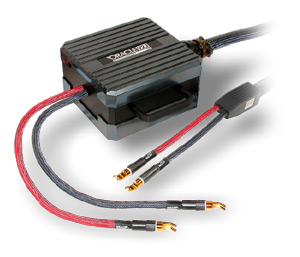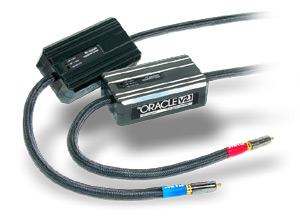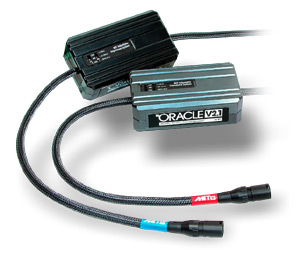![[SoundStage!]](../titles/sslogo3.gif) Home
Audio Home
Audio Equipment Review |
|||||||||||||||||
May 2003 Music Interface Technologies Oracle v2.1 Interconnects and Speaker Cablesby Marc Mickelson
Audiophiles express their cynicism about products all the time -- it's part of being an audiophile -- but more of it is aimed at interconnects and speaker cables than any other product category. It's easy to be cynical about audio cables. While there are a good number of companies producing technically based, real products, there others whose claims and pricing are more than a little suspect. That there is money to be made in the cable game is without question -- some of the oldest, best-known high-end-audio companies manufacture cables -- but audiophiles want to know that the wires they buy are worth what they cost, not what some marketer thinks they can command. Segue to the subject of this review, Music Interface Technology's Oracle v.2.1 interconnects and speaker cables. The total retail price of the products provided to me for review is a shade under $19,000 USD -- the interconnects cost $2995 and $3595 per single-ended and balanced pair respectively, while the speaker cables run a cool $8995. So we're not talking about budget products here, but we are discussing some unique designs whose integral networks aim at making the electrical connection between components less of a concern. MIT does this by addressing inductance, capacitance, and impedance -- the holy trinity of electrical properties with which audio components have to deal. By "balancing" these, MIT would argue, they "tune" the cables for maximum transfer of energy. Cables are then a more natural conduit between components, which perform at higher levels of fidelity than if they were connected with non-networked cables. Talking with MIT about the Oracle line of cables (MIT calls them "interfaces") is a little like discussing fighter jets with a defense contractor. There is only so much you will be told because the company has to protect its work, and the engineering that goes into the final product is not the sort of information that's quickly summed up. Make no mistake about it, MIT is an engineering-driven company, and as I learned, the .1 iterations of the Oracle line grew out of company president and head engineer Bruce Brisson's recent work with manufacturers of hearing aids. Brisson focused in these efforts on improving articulation -- like fine audio systems, hearing aids are not so much about sheer loudness as about making clear what they're reproducing. Through this work, Brisson realized that there were ways he could improve all of MIT's cable products. So while the Oracle line may be the most obvious recipient of Brisson's efforts, the technology inherent in Oracle .1 upgrades is at work in other MIT cables as well. Oracle v2.1 falls directly in the middle of MIT's top line, and the .1 enhancements occur mainly in the realm of increasing the poles, or "articulation points," in the networks themselves along with the use of better passive parts. There are three versions of each Oracle cable, and the distinction corresponds to the equipment that will be used downstream from the interconnects or to the amplifier that will drive the speakers. Ultra-Wide is meant for use with solid-state electronics from makers such as Spectral, Halcro, and Pass Labs, whose products have bandwidths that push the limits of measurement equipment. Wide covers the rest of the solid-state crowd, while EX, which stands for "exceptions," is meant for tubes. Oracle interconnects also include built-in switches that are adjusted based on the input impedance of the component with which the interconnects will be used.
The fundamental difference among the Oracle models -- v1.1 versus v2.1 versus v3.1, that is -- has to do with how well the cables measure in terms of what MIT calls "articulation response," a complex definition of which you can find on MIT's very informative website. Although Oracle v3.1 doesn't measure as well as v2.1, which in turn doesn't measure as well as v1.1 (you can see measurements for all three online), the gang at MIT still claims that Oracle v3.1 cables measure far and away better than cables from just about any other maker. In terms of their build, the Oracle v2.1 cables use proprietary RCA connectors -- different ones at each end because of the directional nature of the cables -- very beefy spade connectors, and network housings that are far more solid and visually appealing than the chassis for a good many electronics. The speaker cables come in two pieces and are connected by a large screw-on coupler. If you like your audio cables to be noticed, Oracle v2.1 is for you. Use I received for review Oracle v2.1 EX interconnects and speaker cables for use with my reference Lamm electronics: ML2 mono amplifiers and L2 Reference preamplifier. Speakers were Wilson Audio WATT/Puppy 7s, with a WATCH Dog subwoofer augmenting them in the extreme low bass. Digital gear consisted of Bel Canto DAC2 and Zanden Audio Model 5000 Mk III digital-to-analog converters, a Mark Levinson No.390S CD player/transport, and an Esoteric DV-50 universal audio/video player. I also had on hand a pair of Lamm ML1.1 mono amps and an Audio Research Reference Two Mk II preamp. The Lamm amplifiers and preamp rested on Silent Running Audio VR 3.0 isoBases, while the digital players/transports sat on a Bright Star Audio Big Rock base and Townsend Audio Seismic Sink. Power cords were all from Shunyata Research -- Anaconda Vx, Taipan, and Python -- while power conditioning fell to a Shunyata Research Hydra or Sound Application XE-12S with 20A Elrod Power Systems EPS-3 power cord. Interconnects and speaker cables used for comparison were from Stereovox.(SEI-600 and LSP-600). One physical issue with using networked cables is the networks themselves. They're large and heavy, and they often make it difficult to snake the cables around other components and equipment racks. My solution was to use cable ties and loosely affix the cables near their networks to my equipment racks. I then rested the networks vertically on the back edge of one shelf. The networks for the speaker cables are several times the size and weight of those for the interconnects, but luckily they are near the downstream end and can easily sit behind the speakers. Before ample break-in, the Oracle v2.1 cables sounded fuzzy, constricted, and dynamically dead -- a sonic mess. Luckily, their sound improves markedly in short order, and within 100 hours or so the cables had reached their sonic peak. However, over time -- months, in the case of this review -- the cables continued to improve in almost every way. More than any other cables I've come across, including other networked cables like Transparent Reference XL, the MIT Oracle v2.1s thrive by having signal run through them constantly. So if you are underwhelmed when you first put these cables into your system -- and I expect you will be -- be patient. MIT has its own formula for breaking in its cables: 75% performance in two days, 100% in two weeks. From my experience, this is a reasonable starting point, but don't consider it gospel. Oracle oratory Once the Oracle v2.1 interconnects and speaker cables are properly broken in, bold pronouncements -- "expectation changing," "paradigm shifting" -- come quickly to mind. Paradoxically, the presentation of Oracle v2.1 is both notably relaxed and highly detailed -- without equal on both accounts. Individual sonic events emerge from the quietest, blackest background I've ever experienced and then materialize with all of the very finest detail and most minute spatial cues intact -- and in lifelike relation to each other. I could speculate that this presentation is a matter of that tremendously noiseless backdrop or great retrieval of detail, but I think I'd only be telling part of the story. I hate to say it, but the word that sums it up best is articulation -- these MIT cables just sound clearer and more intelligible than others I've used. Piano fared particularly well, and in this regard, one of my long-time faves is Danilo Perez's Panamonk [Impulse! IMPD-190]. "Bright Mississippi" is a particularly telling cut. It begins slowly, with plenty of decay in between notes, and then builds to semi-frenzy. The MIT cables were unperturbed, portraying the opening with placidity and the later fireworks with high resolution, each note distinct in its attack and decay, and the dynamics of the cut in lifelike scaling soft to loud. I then I switched over to the JVC XRCD of Red Garland's Groovy [Victor VICJ-60161], which I've been listening to habitually since I purchased it at CES. I immediately thought that there's a certain XRCDness about the Oracle v2.1s. All of the detail is there, and I do mean all of it, but it doesn't call attention to itself. I came to realize that the sound of the Oracle v2.1 cables defies description in many ways. While there are identifiable characteristics, they are so completely integrated into the tapestry of the music the cables help to reproduce that dissecting it all is difficult -- and ruins the achievement. One region in which the Oracle v2.1 cables excel is the same in which other network cables I've heard do particularly well. Their bass is very deep, very powerful, taut, and has terrific dynamic shading. There isn't more bass, but rather bass that's of higher quality. Evolve [Righteous Babe RBR030-0] is the latest release from Ani DiFranco and another fine-sounding recording. The bass guitar on "Promised Land" displays depth and weight, but the way it shifts in volume as well as pitch causes it to positively dance through the song. The Oracle v2.1s help not only extract all of the bass detail, but they do it under less-than-ideal conditions: amidst the ambient spread of the bass throughout the soundstage, similar to the effect of adding a very good subwoofer. While some amps and speakers won't handle such low-end performance with the same proficiency as the Lamms and Wilsons I use, the MIT cables will certainly do their part to enhance whatever bass a system can produce. Soundstaging and the portrayal of space are also areas in which these MIT cables shine. Oftentimes we think that what we're hearing is greater air around performers and more space when a bit of treble emphasis is the root cause. Not with Oracle v2.1, whose high frequencies are not highlighted in the least. Yet these cables portray a continuous soundfield that is spacious and alive. And what of dynamics, which are often a result of an amplifier with lots of headroom or loudspeakers with high sensitivity? I was surprised to hear a greater perceived gap between soft and loud with the Oracle v2.1 cables in my system. Classical music is best for evaluating dynamics because unlike rock or jazz it often builds to crescendo, so it's possible to hear very subtle gradations in loudness. The first batch of SACDs from Pentatone features recordings that are 30 years old, and yet they sound very current. On Beethoven's Symphony No.5 [Pentatone 5186 102], the music accelerates smoothly toward ultimate loudness instead of lurching from soft to loud. I have to give at least some of the credit to the Oracle v2.1 cables. Probably the most important aspect of MIT's Oracle v2.1 cables is their ability to bring about, for lack of a less trite term, pure audio satisfaction. It's a reviewing cliché that such-and-such component caused you "to pull out CD after CD," but this is exactly what the Oracle v2.1 cables did for me. This wasn't due to some list of audiophile-approved pyrotechnics but rather the sense that the sound was just a bit closer to being right. While for the purposes of this review I have been able to identify the minutiae of the sound I heard, my system with the Oracle v2.1 cables always made analysis a chore. They beg you to listen and enjoy, not examine and explain. Comparison Even with all of the considerable sonic merits of the Oracle v2.1 cables, I am convinced that they certainly won't be for everyone, even if their price were a fraction of what it is. Oracle v2.1 won't lighten up a dull-sounding system, and listeners who like their music with lots of high-frequency energy will likely find the relaxed character of these cables boring. It's certainly true that you can't please everyone, and sometimes with audiophiles, you can't please anyone. Of the cables I've reviewed recently, those from Stereovox are the most competitive to the Oracle v2.1s in terms of overall performance and price. They are also similar sonically to Oracle v2.1; choosing one or the other may be a difficult task. I praised the Stereovox SEI-600 and LSP-600 for their balance and ability to convey detail without sounding hyper resolving. These things apply to MIT Oracle v.2.1 as well, but to an even greater extent. The Oracle cables sound even more relaxed and a touch more detailed, even though the Stereovox cables have a lighter overall balance that I would expect to give the impression of greater detail. The bass of the MIT cables is certainly more accomplished, but the low end of the Stereovox cables is not deficient in any way. The Stereovox cables don't have networks, so you won't have to figure out how to accommodate them in your system configuration. I would be very happy with either of these cables as my reference, but if cost were no consideration, I would choose MIT Oracle v2.1 (I might even spring for Oracle v1.1). If cost were an important part of the mix, I would not end up with either of these cable lines and instead investigate Analysis Plus Solo Crystal Oval, which gives a lion's share of the overall performance (albeit with a different mix of traits) at a small fraction of the price. The wisdom of the Oracle While it's almost impossible to convince most audiophiles of the efficacy of cables that cost what the MIT Oracle v2.1s do, I have to say that their sound speaks very loudly for them, and this minimizes the shock of their price. They seduced me with their unique and enthralling musical presentation, and in the process realigned what I have come to think of a cable's contribution to reproduced music. Cables can very much be a matter of proper mating with certain components, and I would be doubly cautious in recommending these Oracle cables if there weren't different versions to mate with different kinds of electronics, thus giving you a better chance of hearing at home what I heard in my listening room. I've reviewed a smorgasbord of accomplished cable designs over the last year or so, and while none has cost as much as Oracle v2.1, none has also impressed me as much either. I wish I could offer some insight that wouldn't be ammo for all of the audio cynics, but I can't. It's clear to me that the most expensive cables I've heard are also the best. In the case of MIT Oracle v2.1, you really do get more when you pay more. ...Marc Mickelson
|
|||||||||||||||||
|
|||||||||||||||||
![[SoundStage!]](../titles/sslogo3.gif) All
Contents All
ContentsCopyright © 2003 SoundStage! All Rights Reserved |


